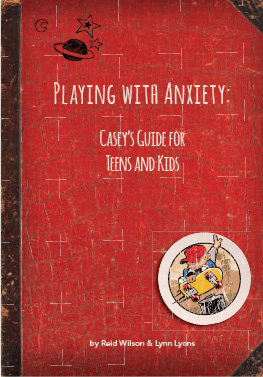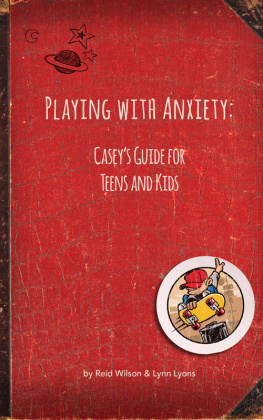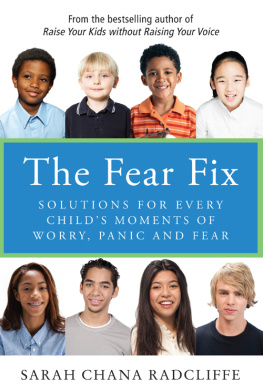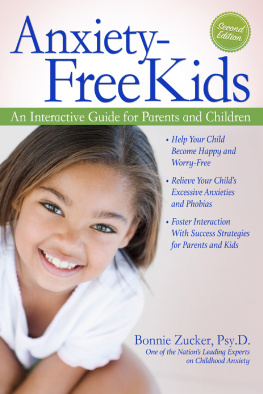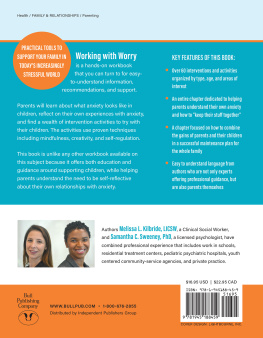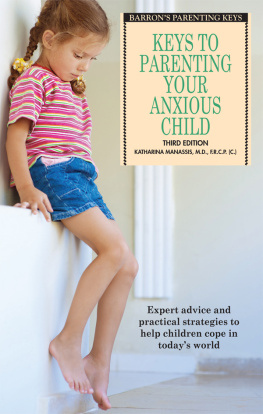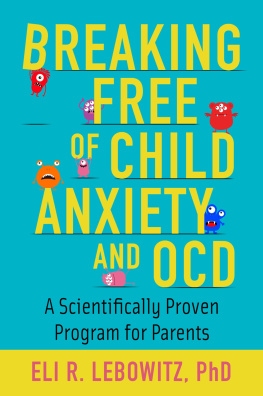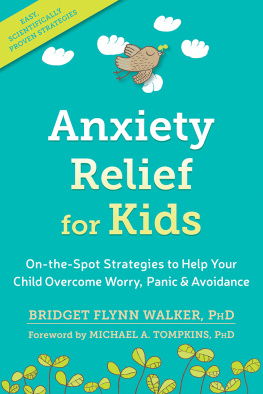Health Communications, Inc.
Deerfield Beach, Florida
www.hcibooks.com
Library of Congress Cataloging-in-Publication Data
Wilson, Robert R. (Robert Reid)
Anxious kids, anxious parents : 7 ways to stop the worry cycle and raise
courageous and independent children / Reid Wilson and Lynn Lyons.
pages cm
ISBN-13: 978-0-7573-1762-0 (Paperback)
ISBN-10: 0-7573-1762-6 (Paperback)
ISBN-13: 978-0-7573-1763-7 (ePub)
1. Anxiety in children. 2. Worry in children. 3. Self-confidence in
children. 4. Parenting. I. Lyons, Lynn. II. Title.
BF723.A5W55 2013
155.4'1246dc23
2013028971
2013 Reid Wilson and Lynn Lyons
All rights reserved. Printed in the United States of America. No part of this publication may be reproduced, stored in a retrieval system, or transmitted in any form or by any means, electronic, mechanical, photocopying, recording, or otherwise, without the written permission of the publisher.
HCI, its logos, and marks are trademarks of Health Communications, Inc.
Publisher: Health Communications, Inc.
3201 S.W. 15th Street
Deerfield Beach, FL 334428190
Cover photo iStockphoto
Cover and interior design by Lawna Patterson Oldfield
e-Pub created by Dawn Von Strolley Grove
To my three guys,
Crawford, Brackett, and Zed,
and of course to my parents,
Ed and Cathleen Gerwig,
with love and appreciation
for everything
Lynn
To Bob, Charlie, Michael, Matt, Jones,
Grayson, Mason, and Emma
Reid
CONTENTS
LETS FACE IT: We parents are great at worrying about our kids. How are they performing in school? Is she safe walking home from her friends house? Should I limit his video gaming?
And we are all so full of good advice, arent we? You had better start working on that paper before the weekend, because youve got that camping trip coming up. When kids are mean to you on the playground, you just have to ignore them and walk away. Five servings of fruits and vegetables a day. Lets put some color on that plate!
But what happens when our sons and daughters start to show more than the average amount of hesitation about normal activities, expressing a degree of fearfulness that seems exaggerated for the circumstance? Suddenly, your son is afraid of anything to do with fire, and nightmares frighten him so that he doesnt want to close his eyes in bed unless you stay with him until long after hes asleep. Perhaps he has become more and more clingy and rarely allows you to be away from him. Is he no longer willing to play on the soccer team or perform in the school band, despite loving these activities in the past? How about spending the night at a friends house? Has it become unthinkable?
Or maybe your daughter has slowly become reticent to go to school. It started out with her staying in bed past the alarm. Then stomachaches. Then more days when she felt too sick to go to school. And now, daily tantrums, fighting you every step of the way. Perhaps she was scared by an aggressive dog last year and still acts frightened every time she hears a dog bark. What loving, caring parent wouldnt become worried in the face of a childs anxious, avoidant behavior? So you offer your very best advice, logic, and encouragement, and nothing seems to help. Its not that you havent tried the following:
You reassure your son about the precautions you take to prevent any fire and how easy it is to call 911 if the rare event were to occur.
You bring your daughter to the pediatrician, who assures her more than once that shes well enough for school. You even implement consequences for stalling in the mornings.
You ask your daughter to come with you for a visit with your neighbors dog, which doesnt have an aggressive bone in its body.
You promise your teenage son that youll keep your cell phone on while youre gone, and that you will come right home if he needs you.
You remind your child of how much fun soccer was last year or how well his trumpet teacher thinks hes doing.
You bribe your daughter if she will join you for a half hour at the park with her friend and mom.
Worry is exhausting for everybody. When anxiety is in charge, parents can feel like life is going in circles. You fix one problem (by handling the worry), and then another one pops up. It seems like theres no end to it.
We feel your pain, and were here to rescue you from the cycle. We have spent our careers treating anxiety disorders. We have a combined fifty years of experience helping hundreds of families as well as school systems and communities support the development of courageous and independent children and teens. The advantage of studying and practicing one task for decades is that you cant help but get good at it. Thats what weve been doing: figuring out what the science tells us about fear, worry, anxiety, and avoidance, and then what studies have shown us about how families can face challenges and step forward in spite of the threat. We have taken all weve learned from the research and from our own clinical experience and applied it to the skills we offer you here.
As parents ourselves, we know it isnt our job to stop worries from showing up, because they appear through all stages of life for all of us. Our children are going to worry, our teens are going to worry, and so are we. Our goal is not to prevent worries; it is to keep anxious fears from dominating our families. Weve mastered some excellent strategies to help parents help their kids enjoy life again, and we give them to you in this book.
Heres a fact you might find surprising. Research shows that anxious children can learn patterns of worry from parents who are only trying to help. Our most common responses to our scared and worried children can end up encouraging them to remain frightened. When we act as worried, frustrated parents, we rarely teach our kids and teens how to stop being worried. Instead, we inadvertently teach them to think and act in ways that reinforce their fear and avoidance. What are some of the most common mistakes we might make?
We try to convince kids that nothing bad is going to happen, that they dont need to worry because they are safe.
We try to reassure them by overdetailing our schedules or the exact nature of upcoming events.
We tell them everything will be fine if they just calm down , and we encourage them to learn skills of relaxation.
We alter the familys plans and school activities to accommodate their fear and keep them comfortable.
We excuse tantrums and outbursts of anger, as though they are an extension of the childs uncontrollable anxiety.
We allow them to see our own anxious behaviors without role modeling any coping strategies.
We become frustrated and angry and make unreasonable demands for our fearful child to just do it.
In this book we explain the problems with all these approaches and teach you alternative ways to address your childs avoidance. Kids and teens must be in charge of pushing past their hesitations and into the wonderful adventures coming up in their future. They need a plan. Then they need to make it into their own plans. You cant force them, and they dont like to be bossed around. But you can partner with your child to turn things around. Here is an example of how things can change for the better:
***
Casey was an anxious, avoidant worrier throughout her childhood. Little signs showed up before kindergarten, as she was shy around other kids and adults. In the first couple years of elementary school, she was afraid of birthday parties, so her mom stayed at the parties with her. They skipped the Fourth of July fireworks at the park each summerjust too scary. If she went to the movies, she sat in the aisle seat in case she felt like she had to leave. All that careful avoiding seemed to work because it kept her from crying, shaking, and yelling.

